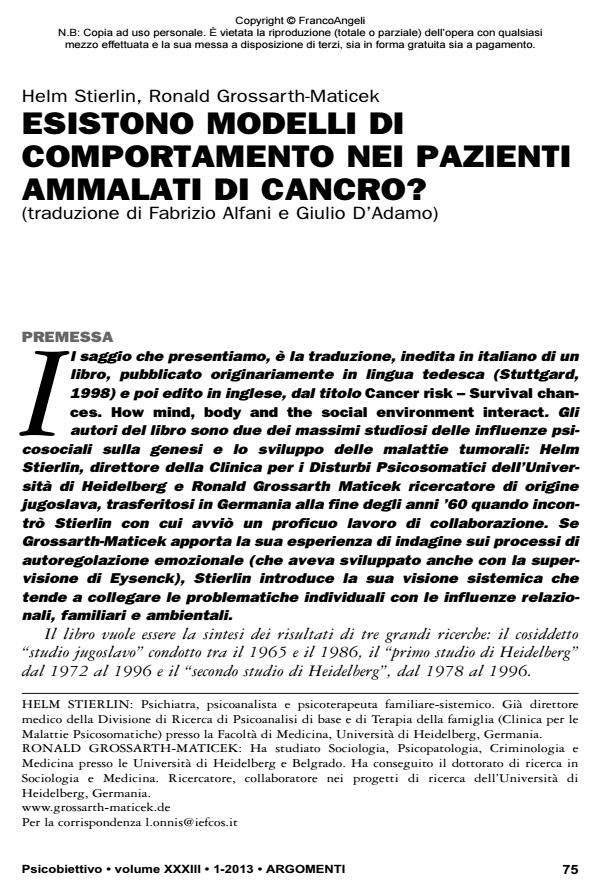Behavior patterns in cancer patients?
Journal title PSICOBIETTIVO
Author/s Helm Stierlin, Ronald Grossarth-Maticek
Publishing Year 2013 Issue 2013/1 Language Italian
Pages 16 P. 75-90 File size 1155 KB
DOI 10.3280/PSOB2013-001006
DOI is like a bar code for intellectual property: to have more infomation
click here
Below, you can see the article first page
If you want to buy this article in PDF format, you can do it, following the instructions to buy download credits

FrancoAngeli is member of Publishers International Linking Association, Inc (PILA), a not-for-profit association which run the CrossRef service enabling links to and from online scholarly content.
In their text the authors intend to concentrate on behaviour patterns which are relevant for the cancer problematic or, more accurately, for the studies on the development, prevention and therapy of cancer. To identify a spectrum of potential risk factors they describe different identification strategies. The authors refer to the Type 1 pattern of behaviour, characterized by inhibition in the gratification and activation of those needs and impulses that the subjects evaluate as being selfish and egoistic. They describe the main features of a prospective intervention strategy in which two groups of people displayed more or less the same kind and incidence of cancer risk factors. One of these groups took part in a preventive therapy that aimed to improve self-regulation and autonomy.
Keywords: Cancer; Prevention; Patterns of Behaviour; Prospective Studies; Psychological Types
- Bahnson C.B. (1976) Emotional and Personality Characteristics of cancer patients, in Southick A.I., Engstrom P. (eds.), Oncological Medicine, University Park Press, Baltimore, pp. 357-378
- Consoli S.M., Cordier S., Ducimetiére P. (1993) “Validation d’un questionnaire de personnalité à repérer des sousgroupes à risque de cardiopathie ischémique ou de cancer dans la cohorte Gazel”, Revue d’Epidémiologie et Santé Publique, 41: 315-326
- Eysenk H.J. (1994) “Cancer, Personality and Stress: Prediction and Prevention”, Advances in Behaviour Research and Therapy, 16: 167-209
- Eysenk H.J., Grossarth-Maticek R., Everitt B. (1991) “Personality, stress, smoking and genetic predisposition as synergistic risk factors for cancer and coronary heart disease”, Integrative Physiological and Behavioral Science, 26: 309-322
- Fernandez-Ballesteros R.M., Zammarron D., Ruis M.A., Sebastian J., Spielberger C.D. (1997) “Assessing emotional expression: Spanish adaptation of the Rationality/Emotional Defensiveness Scale”, Personality and Individual Differences, 22: 719-729
- Glomp I. (1997) “Unerwartet genesen”, Psychologie Heute, 24: 28-39
- Grossarth-Maticek R., Bastiaans J., Kanazir D.T. (1985) “Psychosocial factors as strong predictors of mortality from cancer, ischaemic heart disease and stroke: the Yugoslav prospective study”, J. Psychosom. Res., 29 (2): 167-176
- Grossarth-Maticek R., Eysenck H.J., Vetter H. (1988) “Personality type, smoking habit and their interaction as predictors of cancer and coronary heart disease”, Personality and Individual Differences, 9: 479-495
- Grossarth-Maticek R., Eysenck H.J., Vetter H., Schmidt P. (1988) Psychosocial types and chronic deseases: Results of the Heidelberg prospective psychosomatic intervention study, in Maes S., Spielberger C.D., Defares P.B., Sarason I.G. (eds.), Topics in Health Psychology, Wiley, New York
- Knekt P., Raitasalo R., Heliovaara M., Lethinen V., Pukkala E., Teppo L., Maatela J., Arornaa A. (1966) “Elevated Lung cancer risk among persons with depressed mood”, American Journal of Epidemiology, 144: 1096-1102
- LeShan L. (1977) You Can Fight For Your Life, Harcourt, Brace, Jovanovich, New York
- Le Shan L. (1989) Cancer as a Turning Point, E.P. Dutton, New York
- Minuchin S., Rosman B.L., Baker K. (1978) Psychosomatic Families: Anorexia Nervosa in context, Harvard University Press, Cambridge/Mass.
- Noll P. (1984) Diktate uber Sterben und Tod, mit Totenrede von Max Frische, Pendo, Zurich
- Reznikoff M. (1955) “Psychological factors in breast cancer”, Psychosomatic Medicine 27: 96-108
- Proceedings of a Conference on Spontaneous Remissions in Cancer (1997) International Symposium on Spontaneous Remissions in Cancer, April 17-19, Heidelberg, Germany, pp. 81-90
- Scherg H. (1986) “Zur Kausalitatsfrage in der psychosozialen Krebsforschung”, Psychotherapie und medizinische Psychologie, 36: 98-109
- Schwarz R. (1994) Die Krebspersonlichkeit, Schattauer, Stuttgart
- Selye H. (1984) The stress of Life. Revised Edition, McGraw-Hill, New York
- Simonton O.C., Mathew-Simonton S., Craighton J. (1978) Getting well again, J.P. Tarcher, Los Angeles
- Stierlin H., Levi L.D., Savard R.J. (1973) Centrifugal vs. centripetal separation in adolescence: Two patterns and some of their implications, in Feinstein S., Giovacchini (eds.), Psychiatry. Vol. II. Development and Clinical Studies, Basic Books, New York, pp. 211-239
- Wander M. (1980) Leben ware eine prima Alternative, Luchterhand, Neuwied
- Wirsching M. (1988) Krebs im Kontext/Patient-Familie und Behandlungsystem, Klett-Cotta, Stuttgart
- Wirsching M., Hoffmann H., Stierlin H., Weber G., Wirsching B. (1985) “Prebioptic psychological characteristics of breast cancer patients”, Psychotherapy and Psychosomatics, 43: 69-76
- Zorn F. (1979) Mars, Kindler, Munich
Helm Stierlin, Ronald Grossarth-Maticek, Esistono modelli di comportamento nei pazienti ammalati di cancro? in "PSICOBIETTIVO" 1/2013, pp 75-90, DOI: 10.3280/PSOB2013-001006